
The kimono is a traditional Japanese garment and the national dress of Japan. The kimono is a wrapped-front garment with square sleeves and a rectangular body, and is worn left side wrapped over right, unless the wearer is deceased. The kimono is traditionally worn with a broad sash, called an obi, and is commonly worn with accessories such as zōri sandals and tabi socks.

A T-shirt is a style of fabric shirt named after the T shape of its body and sleeves. Traditionally, it has short sleeves and a round neckline, known as a crew neck, which lacks a collar. T-shirts are generally made of stretchy, light, and inexpensive fabric and are easy to clean. The T-shirt evolved from undergarments used in the 19th century and, in the mid-20th century, transitioned from undergarments to general-use casual clothing.
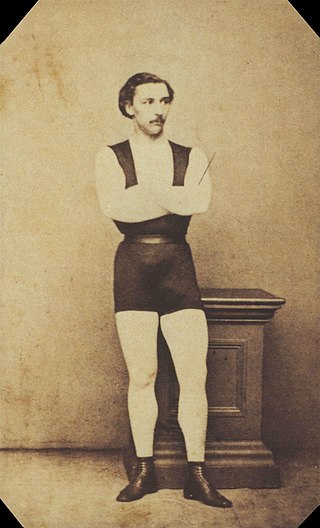
A leotard is a unisex skin-tight one-piece garment that covers the torso from the crotch to the shoulder. The garment was made famous by the French acrobatic performer Jules Léotard (1838–1870). There are sleeveless, short-sleeved, and long-sleeved leotards. A variation is the unitard, which also covers the legs.

A sweater or pullover, also called a jersey or jumper, is a piece of clothing, typically with long sleeves, made of knitted or crocheted material that covers the upper part of the body. When sleeveless, the garment is often called a slipover, tank top, or sweater vest.

A shirt is a cloth garment for the upper body.
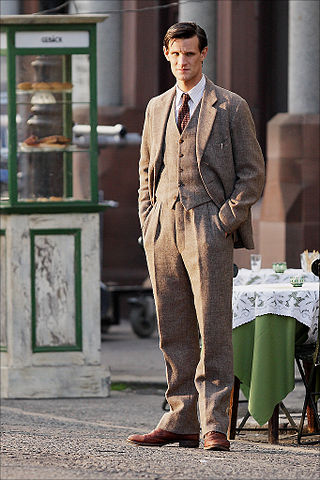
A suit, lounge suit, or business suit is a set of clothes comprising a suit jacket and trousers of identical textiles generally worn with a collared dress shirt, necktie, and dress shoes. A skirt suit is similar, but with a matching skirt instead of trousers. It is currently considered semi-formal wear or business wear in contemporary Western dress codes, however when the suit was originally developed it was considered an informal or more casual option compared to the prevailing clothing standards of aristocrats and businessmen. The lounge suit originated in 19th-century Britain as sportswear and British country clothing, which is why it was seen as more casual than citywear at that time, with the roots of the suit coming from early modern Western Europe formal court or military clothes. After replacing the black frock coat in the early 20th century as regular daywear, a sober one-coloured suit became known as a lounge suit.
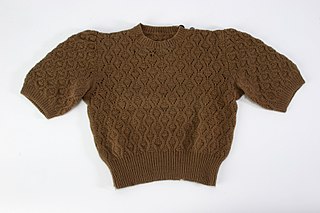
Traditionally, a jersey is an item of knitted clothing, generally made of wool or cotton, with sleeves, worn as a pullover, as it does not open at the front, unlike a cardigan. It is usually close-fitting and machine knitted in contrast to a guernsey that is more often hand knit with a thicker yarn. The word is usually used interchangeably with sweater.

A blouse is a loose-fitting upper garment that may be worn by workmen, peasants, artists, women, and children. It is typically gathered at the waist or hips so that it hangs loosely ("blouses") over the wearer's body. Today, the word most commonly refers to a girl's or woman's dress shirt, although there is considerable confusion between a true blouse and a women's shirt. It can also refer to a man's shirt if it is a loose-fitting style, though it rarely is. Traditionally, the term has been used to refer to a shirt which blouses out or has an unmistakably feminine appearance, although even many "standard" shirts today have a somewhat blousy fit, and the numbers of men wearing such shirts may match that of women wearing actual blouses.
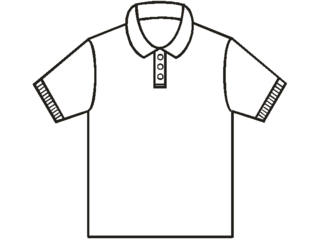
A polo shirt, tennis shirt, golf shirt, or chukker shirt is a form of shirt with a collar. Polo shirts are usually short sleeved but can be long; they were used by polo players originally in India in 1859 and in Great Britain during the 1920s.

1860s fashion in European and European-influenced countries is characterized by extremely full-skirted women's fashions relying on crinolines and hoops and the emergence of "alternative fashions" under the influence of the Artistic Dress movement.

A bathrobe, also known as a housecoat or a dressing gown, is a loose-fitting outer garment worn by people, often after washing the body or around a pool. A bathrobe is considered to be very informal clothing, and is not worn with everyday clothes.
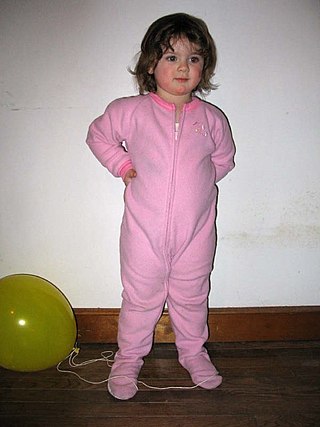
The blanket sleeper is a type of especially warm sleeper or footie pajama worn primarily during the winter in the United States and Canada. The garment is worn especially by young children.
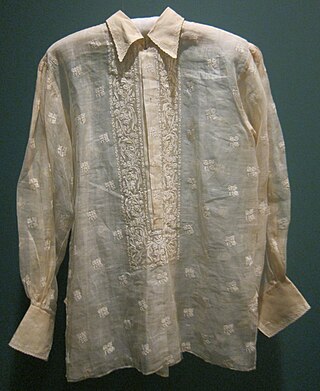
The barong tagalog, more commonly known simply as barong, is an embroidered long-sleeved formal shirt for men and a national dress of the Philippines. Barong tagalog combines elements from both the precolonial native Filipino and colonial Spanish clothing styles. It is traditionally made with sheer textiles (nipis) woven from piña or abacá; although in modern times, cheaper materials like organza silk, ramie or polyester are also used.
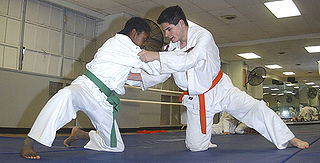
Judogi, also called keikogi or dogi, is the formal Japanese name for the traditional uniform used for Judo practice and competition.

A dress shirt, button shirt, button-front, button-front shirt, or button-up shirt is a garment with a collar and a full-length opening at the front, which is fastened using buttons or shirt studs. A button-down or button-down shirt is a dress shirt with a button-down collar – a collar having the ends fastened to the shirt with buttons.

Sportswear or activewear is athletic clothing, including footwear, worn for sports activity or physical exercise. Sport-specific clothing is worn for most sports and physical exercise, for practical, comfort or safety reasons.

The Brazilian jiu-jitsu gi is the training uniform adapted from the judo keikogi for use in Brazilian jiu-jitsu. A gi, meaning dress or clothes, is composed of a heavy cotton jacket, reinforced drawstring pants, and a belt which communicates rank. Some schools require the jacket and trousers to be the same color, while more relaxed schools do not enforce matching top and bottom color. The Brazilian jiu-jitsu gi is often referred to as kimono by Brazilians. Some Jiu-Jitsu schools avoid using a gi and instead focus on no-gi jiu-jitsu; 10th Planet Jiu Jitsu is an example of this.

Rugby shorts are a type of shorts that are worn while playing rugby. They are designed to take the strains of the game and have traditionally been made from cotton, in 1971 Polyester shorts were worn by international rugby teams such as Wales.

Traditional clothing is one of the factors that has differentiated this nation from neighboring countries, dating back as far as the Illyrian era.

A basketball uniform is a type of uniform worn by basketball players. Basketball uniforms consist of a jersey that features the number and typically the last name of the player on the back, as well as shorts and athletic shoes. Within teams, players wear uniforms representing the team colors; the home team usually wears a lighter-colored uniform, while the visiting team wears a darker-colored uniform.






















